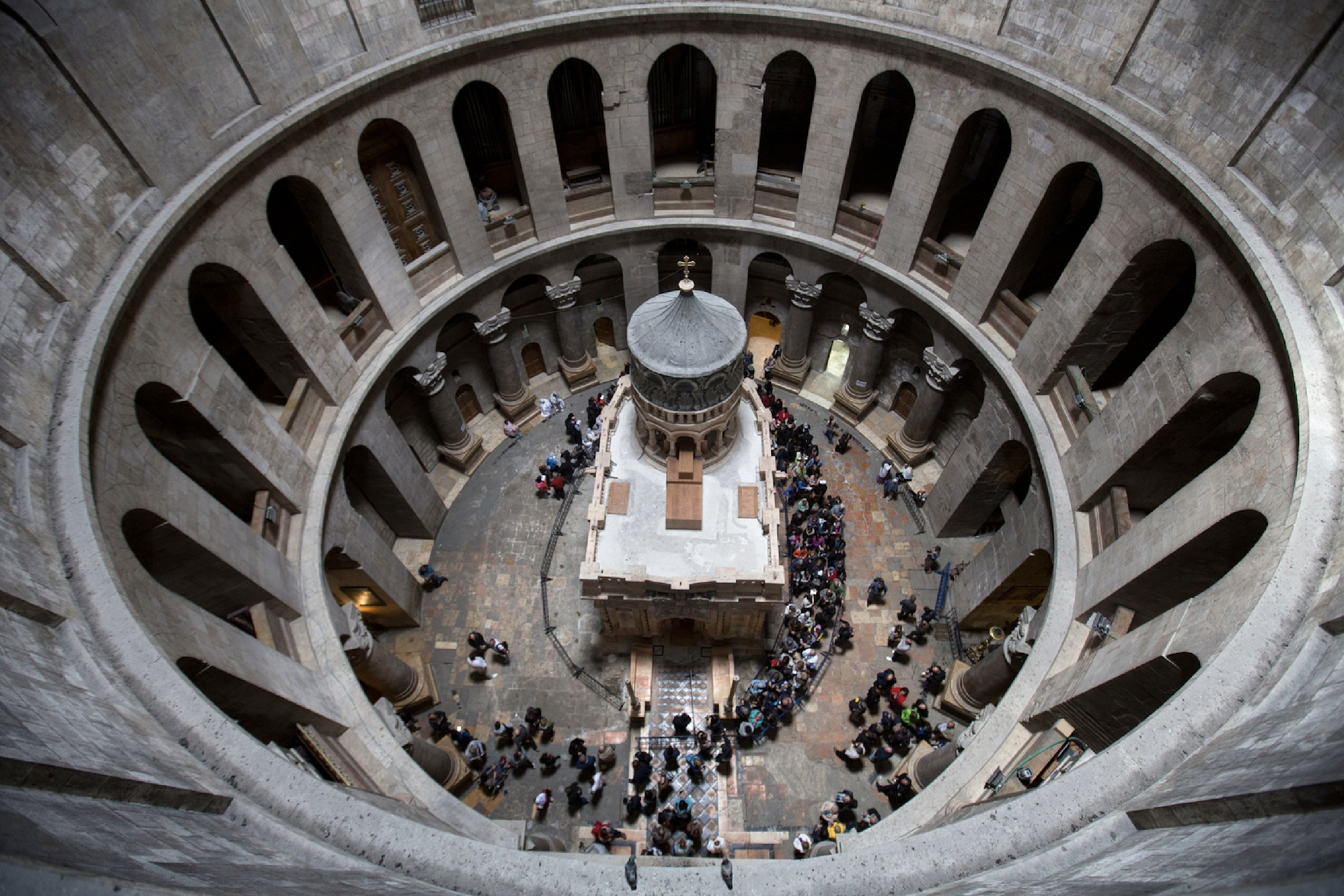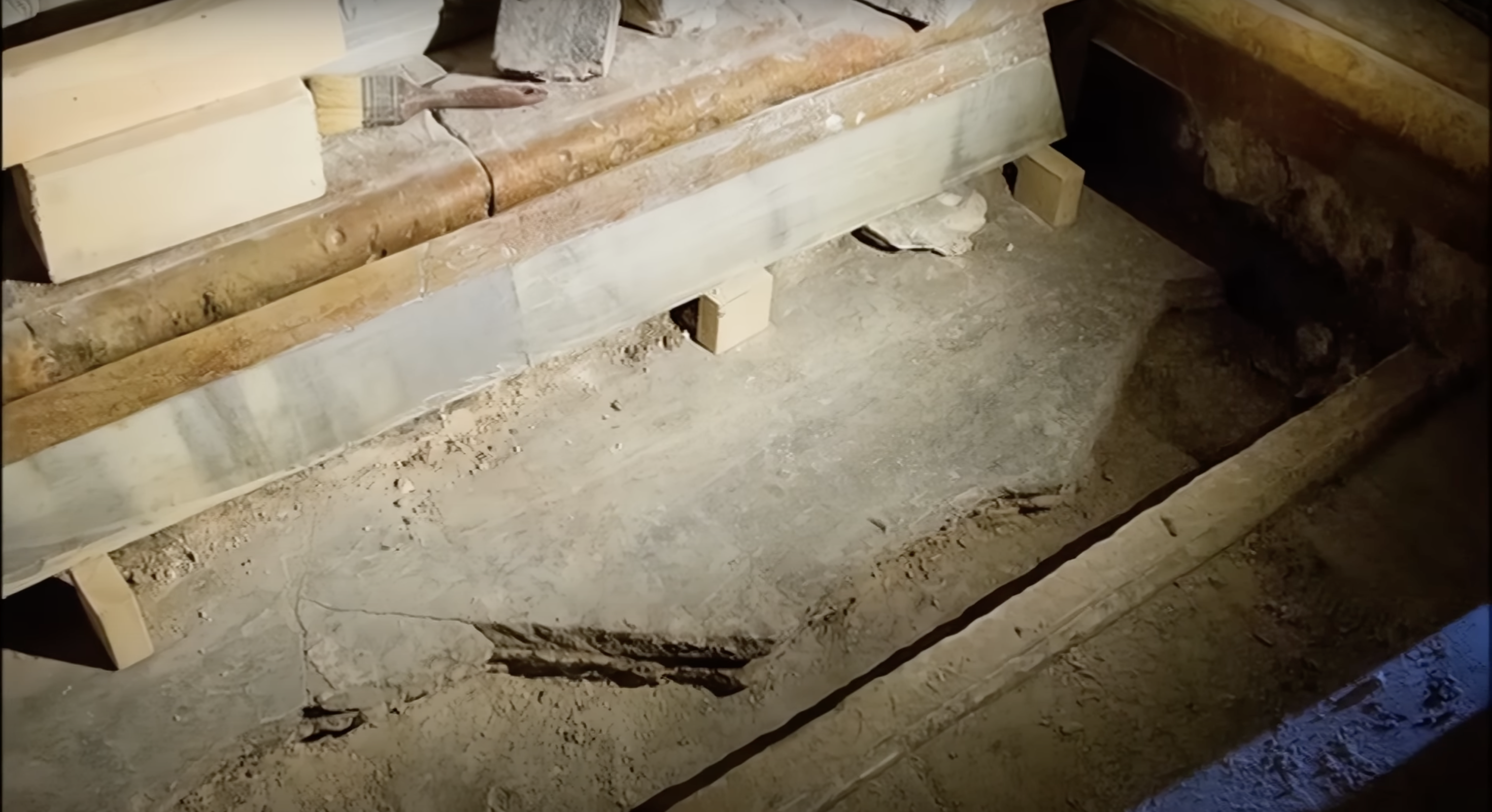Section 169
The tomb visited by the women
Garden tomb at Golgotha
| Matthew 28:1 | Mark 16:1 |
| 1After the Sabbath, at dawn on the first day of the week, Mary Magdalene came to see the tomb along with the other Mary. | 1When the Sabbath was over, Mary Magdalene, Mary the mother of James, and Salome bought spices, so that they might go and anoint Jesus' body. |
Notes
Church of the Holy Sepulcher
Although the Church of the Holy Sepulcher (“tomb”) is now within the city walls, it was outside the walls of Jesus’ day. Various places within the church contain remains from the first century, adding credibility to its identification as the location of Calvary and the empty tomb. Up the stairs you will see bedrock at a considerable height above the current floor; this is all that remains of the outcrop of rock which is the probable location of Calvary.
In A.D. 135 Hadrian built a temple to the goddess Aphrodite directly over this outcrop of rock. In A.D. 326, when the pagan temple was razed, the workmen looked for the tomb of Christ. When they believed they had found the correct one, they dug out the bedrock around the tomb so that it now resembles a small chapel.
Next to a chapel claimed by the Armenians and the Syrians you will have access to several “kokhim”, deep horizontal niches used in first century graves. This area can therefore at least be identified as a place where first century tombs were located outside the city walls—and thus a possibility for the correct location of Jesus’ tomb.
The Garden Tomb, located north of Damascus Gate, was suggested in the 19th century as an alternative site of Calvary and Jesus’ tomb. While the setting is very suggestive of what the garden would have looked like in the time of Jesus, excavations would seem to indicate that the tomb is too ancient to have been the one built by Joseph of Arimathea. The details of the chiseled walls and the bench type of arrangement suggest a date during the Old Testament. Were it not for the New Testament statement that Joseph’s tomb was new, this would have been a possibility.
Tomb of Jesus reveals
Exclusive: Age of Jesus Christ’s purported tomb revealed
By KRISTIN ROMEY published in September 8, 2023 (https://www.nationalgeographic.com/premium/article/jesus-tomb-archaeology-jerusalem-christianity-rome)
Over the centuries, Jerusalem’s Church of the Holy Sepulchre has suffered violent attacks, fires, and earthquakes. It was totally destroyed in 1009 and subsequently rebuilt, leading modern scholars to question whether it could possibly be the site identified as the burial place of Christ by a delegation sent from Rome some 17 centuries ago.
The results of scientific tests provided to National Geographic appear to confirm that the remains of a limestone cave enshrined within the church are indeed remnants of the tomb located by the ancient Romans.
Mortar sampled from between the original limestone surface of the tomb and a marble slab that covers it has been dated to around A.D. 345. According to historical accounts, the tomb was discovered by the Romans and enshrined around 326.
Until now, the earliest architectural evidence found in and around the tomb complex dated to the Crusader period, making it no older than 1,000 years.
While it is archaeologically impossible to say that the tomb is the burial site of an individual Jew known as Jesus of Nazareth, who according to New Testament accounts was crucified in Jerusalem in 30 or 33, new dating results put the original construction of today's tomb complex securely in the time of Constantine, Rome's first Christian emperor.
The tomb was opened for the first time in centuries in October 2016, when the shrine that encloses the tomb, known as the Edicule, underwent a significant restoration by an interdisciplinary team from the National Technical University of Athens. A look inside the tomb of Christ Several samples of mortar from different locations within the Edicule were taken at that time for dating, and the results were recently provided to National Geographic by Chief Scientific Supervisor Antonia Moropoulou, who directed the Edicule restoration project.
When Constantine's representatives arrived in Jerusalem around 325 to locate the tomb, they were allegedly pointed to a Roman temple built some 200 years earlier. The Roman temple was razed and excavations beneath it revealed a tomb hewn from a limestone cave. The top of the cave was sheared off to expose the interior of the tomb, and the Edicule was built around it.
A feature of the tomb is a long shelf, or "burial bed," which according to tradition was where the body of Jesus Christ was laid out following crucifixion. Such shelves and niches, hewn from limestone caves, are a common feature in tombs of wealthy 1st-century Jerusalem Jews. The marble cladding that covers the "burial bed" is believed to have been installed in 1555 at the latest, and most likely was present since the mid-1300s, according to pilgrim accounts.
When the tomb was opened on the night of October 26, 2016, scientists were surprised by what they found beneath the marble cladding: an older, broken marble slab incised with a cross, resting directly atop the original limestone surface of the "burial bed." Some researchers speculated that this older slab may have been laid down in the Crusader period, while others offered an earlier date, suggesting that it may have already been in place and broken when the church was destroyed in 1009.
No one, however, was ready to claim that this might be the first physical evidence for the earliest Roman shrine on the site. The new test results, which reveal the lower slab was most likely mortared in place in the mid-fourth century under the orders of Emperor Constantine, come as a welcome surprise to those who study the history of the sacred monument. "Obviously that date is spot-on for whatever Constantine did," says archaeologist Martin Biddle, who published a seminal study on the history of the tomb in 1999. "That's very remarkable."
During their year-long restoration of the Edicule, the scientists were also able to determine that a significant amount of the burial cave remains enclosed within the walls of the shrine.
Mortar samples taken from remains of the southern wall of the cave were dated to 335 and 1570, which provide additional evidence for construction works from the Roman period, as well as a documented 16th-century restoration. Mortar taken from the tomb entrance has been dated to the 11th century and is consistent with the reconstruction of the Edicule following its destruction in 1009. "It is interesting how [these] mortars not only provide evidence for the earliest shrine on the site, but also confirm the historical construction sequence of the Edicule," Moropoulou observes.
The mortar samples were independently dated at two separate labs using optically stimulated luminescence (OSL), a technique that determines when quartz sediment was most recently exposed to light.
The scientific results were published by Moropoulou and her team in 2018 issue of the Journal of Archaeological Science: Reports.
This article was originally published on November 28, 2017 and updated to reflect the publication of the journal article on the dating of the mortar.
Editor's Note: All studies are conducted within the framework of the project "Conservation, reinforcement and repair interventions for the rehabilitation of the Holy Aedicule of the Holy Sepulchre in the All-Holy Church of Resurrection in Jerusalem," supervised by the interdisciplinary National Technical University of Athens (NTUA) team for the Protection of Monuments, i.e. Em. Korres, A. Georgopoulos, A. Moropoulou, C. Spyrakos, and Ch. Mouzakis with A. Moropoulou as Chief Scientific Supervisor. The dated mortar samples were analyzed by the Laboratory of Materials Science and Engineering, School of Chemical Engineering, National Technical University of Athens (Prof. A. Moropoulou, E. Delegou, M. Apostolopoulou, and A. Kolaiti) and the Laboratory of Archaeometry, Department of History, Archaeology and Cultural Resources Management, University of the Peloponnese (Prof. N. Zacharias and E. Palamara).
Deutsch
Українська
Photos
Holy Sepulchre

Holy Sepulchre - Edicule
Tomb of Jesus

Excavated limestone bed



















